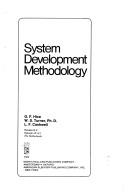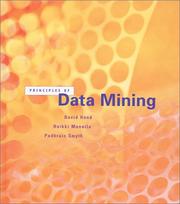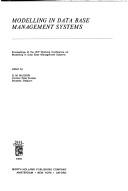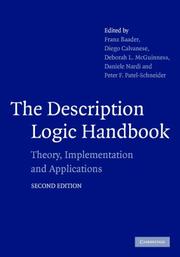| Listing 1 - 10 of 22 | << page >> |
Sort by
|
Book
ISBN: 012800987X 0128010622 0128053429 9780128053423 Year: 2019 Publisher: San francisco: Morgan Kaufmann,
Abstract | Keywords | Export | Availability | Bookmark
 Loading...
Loading...Choose an application
- Reference Manager
- EndNote
- RefWorks (Direct export to RefWorks)
681.3*H1 --- Human-computer interaction --- 681.3*H1 Models and principles (Information systems) --- Models and principles (Information systems) --- Computer-human interaction --- Human factors in computing systems --- Interaction, Human-computer --- Human engineering --- User-centered system design --- User interfaces (Computer systems)
Book
ISBN: 9020704346 9789020704341 Year: 1974 Publisher: Leiden: Stenfert Kroese,
Abstract | Keywords | Export | Availability | Bookmark
 Loading...
Loading...Choose an application
- Reference Manager
- EndNote
- RefWorks (Direct export to RefWorks)
Mathematical control systems --- System theory --- Communication Communicatie --- Information Informatie --- Méthodes Methoden --- Sciences Wetenschappen --- Techniques Technieken --- 519.7 --- 681.3*H1 --- Systems, Theory of --- Systems science --- Science --- Mathematical cybernetics --- Models and principles (Information systems) --- Philosophy --- 681.3*H1 Models and principles (Information systems) --- 519.7 Mathematical cybernetics

ISBN: 0070497435 9780070497436 Year: 1977 Publisher: New York: McGraw-Hill,
Abstract | Keywords | Export | Availability | Bookmark
 Loading...
Loading...Choose an application
- Reference Manager
- EndNote
- RefWorks (Direct export to RefWorks)
Data structures (Computer science) --- Structures de données (Informatique) --- 681.3*E1 --- 681.3*H1 --- Information structures (Computer science) --- Structures, Data (Computer science) --- Structures, Information (Computer science) --- Electronic data processing --- File organization (Computer science) --- Abstract data types (Computer science) --- Data structures: arrays; graphs; lists; tables; trees --- Models and principles (Information systems) --- 681.3*H1 Models and principles (Information systems) --- 681.3*E1 Data structures: arrays; graphs; lists; tables; trees
Book
ISBN: 9780262026499 026202649X Year: 2008 Publisher: Cambridge: MIT Press,
Abstract | Keywords | Export | Availability | Bookmark
 Loading...
Loading...Choose an application
- Reference Manager
- EndNote
- RefWorks (Direct export to RefWorks)
Computer systems --- Computer software --- 681.3*H1 --- 681.3*F4 --- 681.3*F4 Mathematical logic and formal languages (Theory of computation) --- Mathematical logic and formal languages (Theory of computation) --- 681.3*H1 Models and principles (Information systems) --- Models and principles (Information systems) --- Software verification --- Verification of software --- Verification of computer systems --- Verification. --- Systèmes informatiques --- Vérification --- Verification --- Systèmes informatiques --- Vérification --- Computer science --- Logiciels --- Artificial intelligence. Robotics. Simulation. Graphics --- Computer systems - Verification --- Computer software - Verification
Book
ISBN: 3110048035 9783110048032 3110833484 9783110833485 Year: 2018 Publisher: Berlin ; Boston : De Gruyter,
Abstract | Keywords | Export | Availability | Bookmark
 Loading...
Loading...Choose an application
- Reference Manager
- EndNote
- RefWorks (Direct export to RefWorks)
Programming --- Planning (firm) --- Management information systems --- Industrial organization --- Business --- Systèmes d'information de gestion --- Industrie --- Affaires --- Congresses --- Congrès --- Organisation, contrôle, etc --- 681.3*H10 --- 681.3*K43 --- -Industrial organization --- -Management information systems --- 681.3*H1 --- Industries --- Organization --- Industrial concentration --- Industrial management --- Industrial sociology --- Trade --- Economics --- Management --- Commerce --- Computerwetenschap--?*H10 --- Computerwetenschap--?*K43 --- Congresses. --- Models and principles (Information systems) --- 681.3*H1 Models and principles (Information systems) --- Systèmes d'information de gestion --- Congrès --- Organisation, contrôle, etc --- Industrial organization - Congresses --- Business - Congresses --- Management information systems - Congresses --- Management information systems. --- Industrial organization. --- Business.

ISBN: 0720420938 0444105883 9780720420937 9780444105882 Year: 1974 Publisher: Amsterdam: New York: North-Holland, American Elsevier,
Abstract | Keywords | Export | Availability | Bookmark
 Loading...
Loading...Choose an application
- Reference Manager
- EndNote
- RefWorks (Direct export to RefWorks)
Information systems --- Computer architecture. Operating systems --- 681.3*H1 --- 681.3*K61 --- Models and principles (Information systems) --- Project and people management: life cycle; staffing; systems analysis and design; systems development; training (Management of computing and information systems) --- 681.3*K61 Project and people management: life cycle; staffing; systems analysis and design; systems development; training (Management of computing and information systems) --- 681.3*H1 Models and principles (Information systems) --- Electronic data processing --- Management information systems --- System Analysis --- System Design --- System analysis --- Informatique --- Informatique de gestion --- Analyse de systèmes --- Systèmes, Conception de. --- System analysis.

ISBN: 026208290X 1282096362 0262256304 1423731328 9780262256308 9780262082907 Year: 2001 Publisher: Cambridge (Mass.): MIT Press,
Abstract | Keywords | Export | Availability | Bookmark
 Loading...
Loading...Choose an application
- Reference Manager
- EndNote
- RefWorks (Direct export to RefWorks)
Artificial intelligence. Robotics. Simulation. Graphics --- Information systems --- Data mining. --- Exploration de données (Informatique) --- Data mining --- 681.3*H2 --- 681.3*I2 --- 681.3*H1 --- 681.3*H3 --- 681.3*H4 --- Algorithmic knowledge discovery --- Factual data analysis --- KDD (Information retrieval) --- Knowledge discovery in data --- Knowledge discovery in databases --- Mining, Data --- Database searching --- Database management: security; integrity; protection--See also {?681.5*E5} --- Artificial intelligence. AI --- Models and principles (Information systems) --- Information storage and retrieval --- Computer science--Information systems applications (GIS etc.) --- 681.3*H1 Models and principles (Information systems) --- 681.3*I2 Artificial intelligence. AI --- 681.3*H2 Database management: security; integrity; protection--See also {?681.5*E5}

ISBN: 0720404592 9780720404593 Year: 1976 Publisher: Amsterdam: North-Holland,
Abstract | Keywords | Export | Availability | Bookmark
 Loading...
Loading...Choose an application
- Reference Manager
- EndNote
- RefWorks (Direct export to RefWorks)
informatica --- dataprocessing --- Information systems --- Computer architecture --- Database management --- #TCPW P4.0 --- #TCPW P4.2 --- 681.3*A0 --- 681.3*H1 --- 681.3*H20 --- 681.3*H2 --- 681.3*H1 Models and principles (Information systems) --- Models and principles (Information systems) --- 681.3*A0 General --- General --- 681.3*H2 Database management: security; integrity; protection--See also {?681.5*E5} --- Database management: security; integrity; protection--See also {?681.5*E5} --- Congresses --- Computerwetenschap--?*H20 --- Congresses. --- Database management - Congresses --- Computer architecture - Congresses --- Data base management systems symposium --- Data modelling --- Information modelling

ISBN: 9783540301547 3540301542 3642067654 9786610618156 1280618159 3540303278 Year: 2006 Publisher: Berlin: Springer,
Abstract | Keywords | Export | Availability | Bookmark
 Loading...
Loading...Choose an application
- Reference Manager
- EndNote
- RefWorks (Direct export to RefWorks)
Business applications are designed using profound knowledge about the business domain, such as domain objects, fundamental domain-related principles, and domain patterns. Nonetheless, the pattern community's ideas for software engineering have not impacted at the application level, they are still mostly used for technical problems. This book takes exactly this step: it shows you how to apply the pattern ideas in business applications and presents more than 20 structural and behavioral business patterns that use the REA (resources, events, agents) pattern as a common backbone. If you are a developer working on business frameworks, you can use the patterns presented to derive the right abstractions (e.g., business objects) and to design and ensure that the meta-rules (e.g., process patterns) are followed by the developers of the actual applications. And if you are an application developer, you can use these patterns to design your business application, to ensure that it does not violate the domain rules, and to adapt the application to changing requirements without the need to change the overall architecture. As with patterns in general, this approach allows for both more flexible and more solid software architectures and hence better software quality. "It's a great book, marvelous in breadth and depth. An impressive achievement. I particularly liked the modeling handbook examples." Bob Haugen, Business Technology Consultant and Contributor to REA standardization in ISO, UN/CEFACT and ebXML, UK "I enjoyed reading it very much, it gave many new insights into REA and its applications." Paul Johannesson, Stockholm University and Royal Institute of Technology, Sweden "This book by Pavel Hruby is destined to become a landmark in business modeling. Pavel heralds the replacement of traditional workflow-oriented modeling with a new breed of approaches that focus on delivering change-resilient and highly reusable business models. I highly recommend this book to you!" Kr
Business --- Model-driven software architecture --- Computer programs --- Computer software --- Model-driven software architecture. --- Computer programs. --- Development. --- Information Technology --- Software Engineering --- Programming --- Business policy --- 681.3*D2 --- 681.3*H1 --- 681.3*J1 --- 681.3*J1 Administrative data processing (Computer applications) --- Administrative data processing (Computer applications) --- 681.3*H1 Models and principles (Information systems) --- Models and principles (Information systems) --- 681.3*D2 Software engineering: protection mechanisms; standards--See also {681.3*K63}; {681.3*K51} --- Software engineering: protection mechanisms; standards--See also {681.3*K63}; {681.3*K51} --- MDA (Model-driven software architecture) --- Software architecture --- Development --- Business - Computer programs

ISBN: 9780521876254 9780511711787 9780521150118 0521876257 0521150116 Year: 2010 Publisher: Cambridge: Cambridge university press,
Abstract | Keywords | Export | Availability | Bookmark
 Loading...
Loading...Choose an application
- Reference Manager
- EndNote
- RefWorks (Direct export to RefWorks)
Description Logics are embodied in several knowledge-based systems and are used to develop various real-life applications. The Description Logic Handbook provides a thorough account of the subject, covering all aspects of research in this field, namely theory, implementation, and applications. Its appeal will be broad, ranging from more theoretically-oriented readers, to those with more practically-oriented interests who need a sound and modern understanding of knowledge representation systems based on Description Logics. As well as general revision throughout the book, this new edition presents a new chapter on ontology languages for the semantic web, an area of great importance for the future development of the web. In sum, the book will serve as a unique reference for the subject, and can also be used for self-study or in conjunction with Knowledge Representation and Artificial Intelligence courses.
681.3*F4 --- 681.3*H1 --- 681.3*I23 --- Description logics --- Logics, Description --- Knowledge representation (Information theory) --- Predicate (Logic) --- Mathematical logic and formal languages (Theory of computation) --- Models and principles (Information systems) --- Deduction and theorem proving: answer/reason extraction reasoning resolution metatheory mathematical induction logic programming (Artificial intelligence) --- 681.3*H1 Models and principles (Information systems) --- 681.3*F4 Mathematical logic and formal languages (Theory of computation) --- 681.3*I23 Deduction and theorem proving: answer/reason extraction reasoning resolution metatheory mathematical induction logic programming (Artificial intelligence) --- Logiques de description --- 681.3*I23 Deduction and theorem proving: answer/reason extraction; reasoning; resolution; metatheory; mathematical induction; logic programming (Artificial intelligence) --- Deduction and theorem proving: answer/reason extraction; reasoning; resolution; metatheory; mathematical induction; logic programming (Artificial intelligence) --- Description logics - Handbooks, manuals, etc.
| Listing 1 - 10 of 22 | << page >> |
Sort by
|

 Search
Search Feedback
Feedback About UniCat
About UniCat  Help
Help News
News